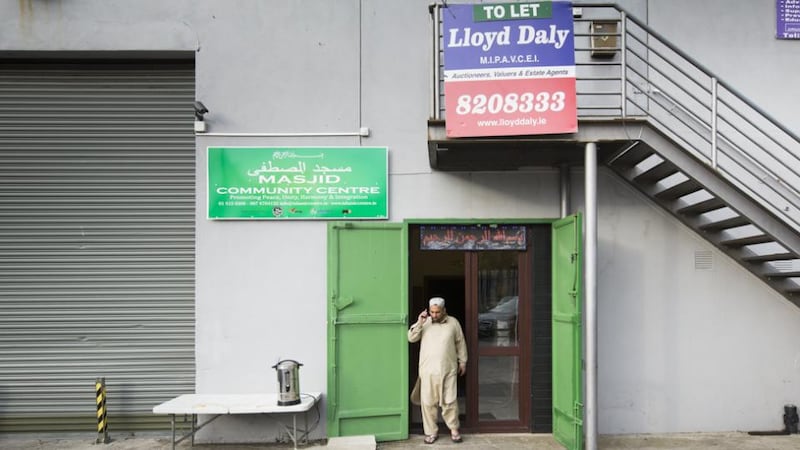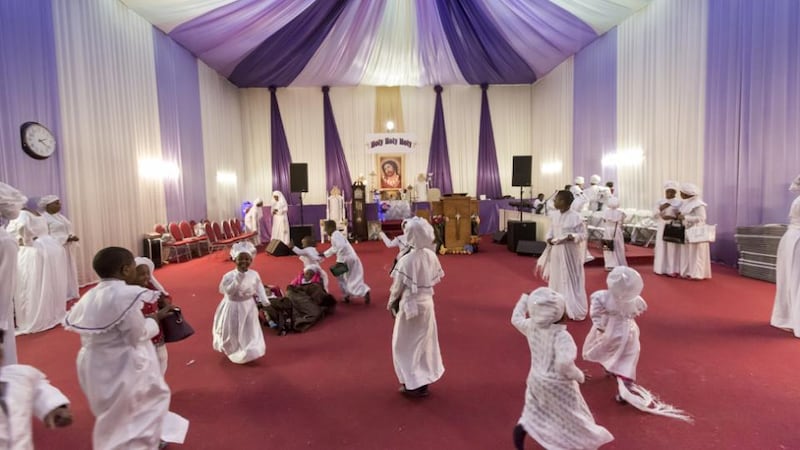One day there was a knock on the door of Denis Byrne Architects in Dublin's North Great George's Street and Maggie Moran opened it to find a tall, dark, handsome Nigerian man standing there. "Pastor John wore the sharpest Italian suits I have ever seen," she says, recalling the initial connection with the man who was to become a client and which led – 12 years later – to the opening of the Sacred Space exhibition now running in the Darc Space gallery set up by the architects' practice in 2010.
Pastor John contacted the practice because he ran a church in nearby Rutland Lane in a building which had caught the attention of the authorities and neighbours. For the former there were regulatory issues – such as parking and fire escapes – and Pastor John was subject to “more and more red tape”, says Denis Byrne, who was charged with creating a suitable new pray space for the church.
Eventually this led them out of town – with its complex legislation – and to an unlikely sounding warehouse in Ballyfermot. Not anyone’s initial concept when envisaging a church, but suitable because parking is easy, interiors are large, rents are low and there are no near neighbours ready to phone the council and complain about chanting and singing.


Having happily settled that congregation in peaceful surroundings, Moran and Byrne were then contacted by Pastor John’s friend, Pastor Anthony, from the Mountain of Fire and Miracles.
Quaker Meeting House
This established their work with religious organisations and further opened their eyes to the sacred spaces in all sorts of buildings – often commercial – in the city. “We were aware of a mosque above the shoe shop in Talbot Street,” says Byrne. “Brilliantly, when they left – through a tiny door – the street was full of Islam for half an hour: full of exotic people.”
The practice also got thinking about city spaces that had been converted away from religion, such as Rush Library in a former Catholic church, by McCullough Mulvin Architects; the Irish Film Institute in Temple Bar in a former Quaker Meeting House and the upgrading of a prayer room in the Carmelite Centre in Clarendon Street by Niall McLaughlin Architects. Also in Dublin there has been a change of use on the South Circular Road of a Presbyterian church into a mosque, while the mosque in Clonskeagh was purpose designed by Michael Collins Architects.
In the book accompanying the exhibition, Charles Duggan charts 39 closures of places of worship in Dublin city since the 1830s: one Roman Catholic, 19 Church of Ireland; five Presbyterian, five Methodist, two Jewish and seven others.
Also lost were many Jewish ritual spaces, such as a former synagogue in Ballybough. But while these sites have been lost, they live on in the collective memory, writes Dr Melanie Brown in the exhibition book. “The Jewishness which surrounds part of Dublin’s built heritage . . . is deeply embedded in the ancient and multi-faceted city itself.”
In a wider context, reuse of buildings helps the country: “The sustainable management and conservation of Ireland’s built heritage can assist in the country’s continued economic recovery,” writes Martin Colreavy, principal adviser on Built Heritage and Architectural Policy at the Department of Arts and Heritage.
But it is to the commercial spaces transformed into places of worship that the exhibition then turns: the sacred spaces hidden in view, with their plain facades opening to a panoply of styles from jewel boxes to monotone interiors. Something that, architect Niall McCullough points out, is akin to how Catholic churches used to be hidden too – behind houses. He points to the church in Francis Street, set well back from the road because it used to be behind homes.
Worshipful venues
In this examination of the making and unmaking of worshipful venues in Dublin, the Sacred Space exhibition (funded by the Department of Arts and Heritage, Dublin City Council and Soprema Ireland) displays the city, say the organisers: "As a place of dynamic change, of human ingenuity and of tremendous community spirit."
In collating the exhibition, photographer Eugene Langan spent months and months getting to know Christian, Muslim, Hindu and Sikh communities – worshipping in the plethora of commercial buildings, including factories, industrial units, an outpatients’ clinic and a suburban cinema – and persuading them to let him photograph their services. Many were welcoming from the start – notably the Hindus and Sikhs: “They immediately said, ‘yeah, come in’.The Sikhs don’t use the word tolerance about other religions, they use ‘acceptance’,” says Langan.
And so he gained access to many a humdrum edifice and “when I walked in they exploded in front of my eyes – ranging from disciplined decor to an explosion of colour”.
On the exuberant side, were fabricated fantasies draped with purple material, garlands of colourful lights, pink walls and gold and velvet chairs, while others comprised stark, officey spaces with standard plastic chairs. And sometimes the two contrast: high emotion in low-key interiors. While other interiors spoke directly to the worship, such as in the carpet in the mosque at Greenhills Industrial Estate in Tallaght etched with lines facing Mecca.
Natural exuberance
One startling thing was how children’s natural exuberance was accommodated. “Some of the ceremonies were raucous, loud and colourful – in two Christian churches they were rolling around on the floor and staggering, imploring god to come down – while others were as austere as Catholic Mass except for the kids who, as the congregation bowed down, would be screaming in the back of the mosque.”
Many photographs depict this brilliantly, such as one in which men kneel with their heads to the floor while a small girl stands out of the sea of worshippers, gazing confidently at the camera. Children swirling in joy feature in another picture. “It is sadly different to my own experience as a Catholic when you had to sit in silence and if any child made a noise to parents they would get daggers,” smiles Langan.
As well as the buildings, the people too are part of the city’s future, says City Architect Ali Grehan, reminding us that Dublin is a member of the Council of Europe’s “Intercultural Cities” programme. “Today, Ireland is no longer a monochrome country but home to people from 200 nations. Dublin has seen the greatest change . . . diversity is an advantage, inclusion an asset.”
Langan recommends going to see the ceremonies, saying most of the people he contacted are welcoming: “I have been privileged to experience the happenings in these churches, mosques and temples. It was a jaw-dropping experience to see such intense and diverse religious practice taking place all over contemporary Dublin.”
Sacred Space at Darc Space, 26 North Great George's Street, Dublin 1, runs until May 1










